This post contains affiliate links. Please read my disclosures.
An easy everyday gluten-free white bread can seem like an impossible ask. Well this Gluten-Free White Sandwich Loaf is the answer to all your bread cravings. It’s an incredibly easy bread made with instant yeast, no xanthan gum, it’s rice-free, there is no kneading and only requires one prove. The results are a deliciously tasty and soft loaf with a lovely golden crust. With a few simple swaps you can also make a delicious gluten-free vegan white bread.
Baking a Gluten-Free White Sandwich Loaf can seem complicated and daunting, even if you are a seasoned baker and especially if you are familiar with the regular bread making process.
In gluten-free bread recipes there may be the odd unfamiliar ingredient, you may think vital steps are being missed and the ingredient list may be slightly longer than you are used to.
Well, I am here to take you through the whole process. I will be breaking down each step and will introduce you to each ingredient to explain exactly why they have been chosen for this recipe and what their role is in the process.
My hope is that you will soon realise that baking a successful gluten-free white sandwich bread can be easy, foolproof and will give you deliciously tasty, soft and fluffy results that can be eaten everyday and at any time of day.
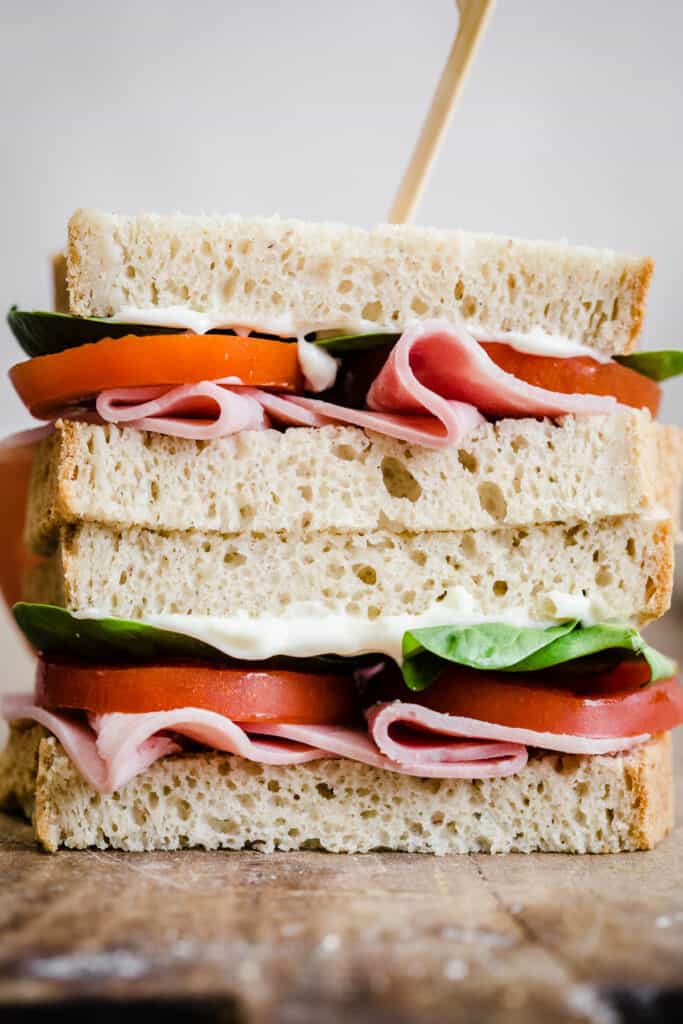
Table of contents
- Why you’ll love this recipe
- Watch the video to see how to make it
- Gum-Free Gluten-Free Bread
- What ingredients do we need?
- How to make it
- Tools you'll need
- Ingredients you'll need
- Troubleshooting: My bread won’t rise
- Gluten-Free Vegan White Bread
- How to store
- How to freeze
- More gluten-free bread recipes you’ll love
Why you’ll love this recipe
- The bread dough is quick to come together. You can use a stand mixer but it’s not necessary.
- There is no xanthan gum in this recipe so perfect if you are intolerant to gums.
- This is also a rice-free gluten-free bread.
- The dough only needs one rise and I’ll share my tips on guaranteeing a sky high loaf.
- This gluten-free soft sandwich loaf has a lovely open crumb and not too crusty crust.
- Delicious taste that is both neutral in flavour but not in any way bland.
- This recipe can easily be made vegan.
Watch the video to see how to make it
Gum-Free Gluten-Free Bread
The omnipresence of xanthan gum in gluten-free bread baking can be frustrating if you are intolerant or need to avoid gums.
READ MORE >>> Why I don't bake with xanthan gum
I’m here to tell you happily that you do not need xanthan gum to produce a delicious gluten-free white bread loaf with an elastic dough, lovely oven spring and a light soft fluffy crumb. So what do we use instead?
- Gluten-free flours. We choose starchy flours that are that will give great structure to our bread.
- Psyllium husk. This is an ingredient which you might not be as familiar with but it’s hugely popular in gluten-free baking as it creates a strong elastic gel when mixed with water which will give softness and bounce to you bread. It’s incredibly simple to use, easy to source and is an invaluable ingredient in this bread.
- Egg whites. Strengthens the bread and adds more elasticity to the dough.
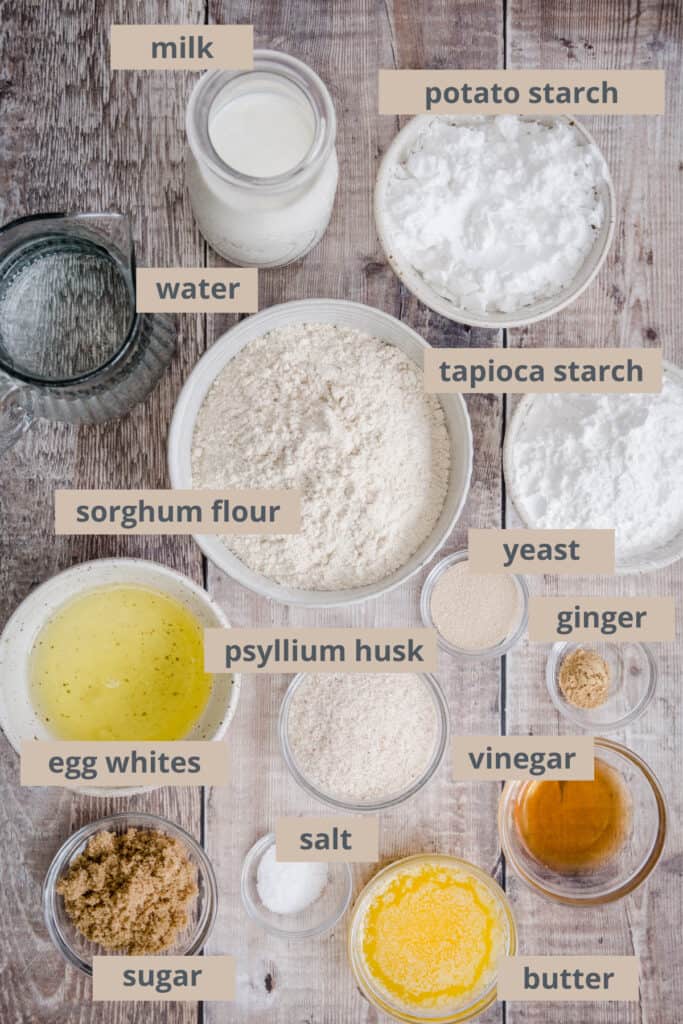
What ingredients do we need?
Dry active yeast
This recipe uses a quick dry active yeast. Make sure it is gluten-free though, it’s surprising how many brands are not. Also, check the expiry date. The yeast should be from a freshly opened packet (or at least one that hasn’t been hanging around for a couple of months in your cupboard).
Milk
We mix our dry yeast initially with warm milk. Milk adds vital protein to the bread to help it rise and also softens the crust. Make sure the milk is at the right temperature to activate the yeast (between 100-115 F / 38-46C). Too cold and the yeast won’t wake up and too warm and it will kill it. I recommend using a digital thermometer if you have one.
Sugar
Sugar is mixed with the dry yeast to feed and activate it when you are initially adding it to the milk. It also keeps the bread soft and helps it to brown. Brown sugar is chosen for flavour.
Psyllium husk
This ingredient is high in fibre which you can source from health food shops. It works as an excellent binding agent in this recipe and gives the finished loaf a softness and elasticity. Do note, you want to buy the whole husk, not ground.
Sorghum flour
This is a wholegrain flour which will give our loaf a lovely fluffy light crumb and a gentle neutral taste.
READ MORE >>> The Ultimate Guide to Sorghum Flour
Potato starch
This starchy white flour has great binding properties which will give your bread a lovely structure. It is a very fine powdery flour and will give your sandwich loaf a great lightness. It’s great for breads as when added to water and heat the potato starch expands quickly so will make for a tall and fluffy loaf.
Tapioca starch
This is another starchy flour which will add a lightness to your bread and will help to bind the ingredients. It is especially useful as it browns well so will give an excellent golden crust to your loaf.
READ MORE >>> The Ultimate Guide to Tapioca Starch
Butter
We use a good unsalted butter. Fat is needed in the recipe to soften the loaf and butter is chosen for a deliciously rich flavour. You can substitute with a mild olive oil or a plant based butter.
Apple cider vinegar
The acidity of the vinegar helps to keep the bread soft and to preserve the loaf. Use a good brand of apple cider vinegar that includes the mother for delicious flavour complexity.
Egg whites
They add elasticity to the bread and help the ingredients to bind together. You can substitute for aquafaba for a vegan bread without any discernible differnce.
Ground ginger
Sounds a bit odd, right? But ginger helps to activate the yeast and aid in a sky-high loaf. You only need about ½ teaspoon so the flavour can’t be detected in the finished loaf.
Salt
Essential for a tasty bread. Don’t underestimate the amount the recipe requires, without it you could have a bland loaf.
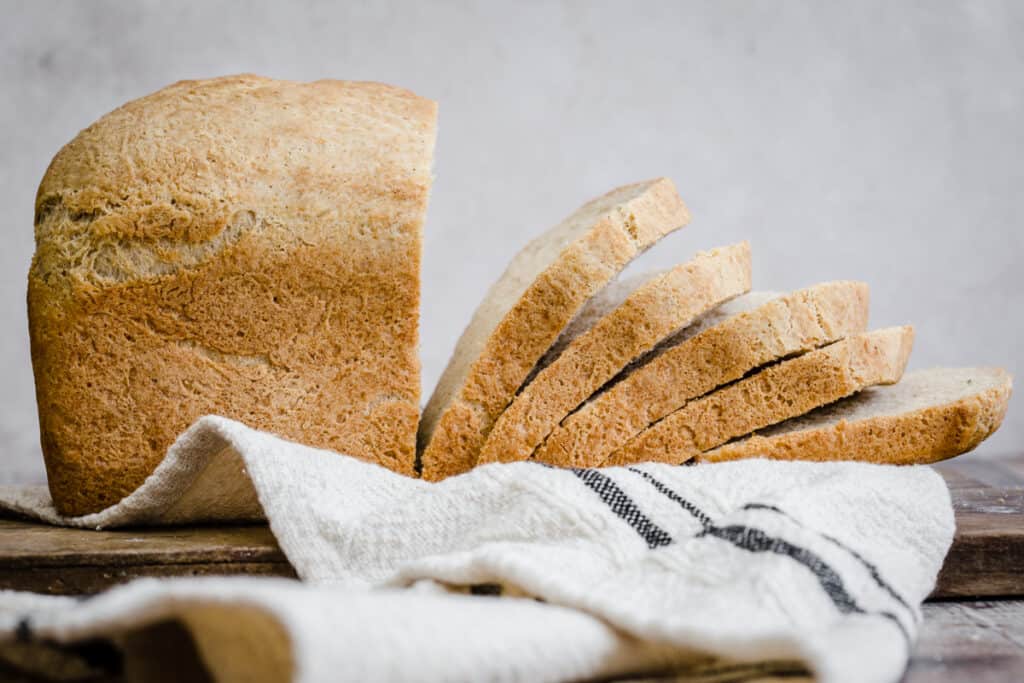
How to make it
For full recipe instructions go to the recipe card at the end of this post.
The steps are simple:
1&2) Yeast. Mix the yeast with warm milk and sugar and let stand for 10 minutes to activate.
TIP. Use a glass bowl and a wooden stirrer, like the end of a wooden spoon or a chopstick, to stir the yeast. Sometimes it can react to metal which will affect the yeast’s activation.
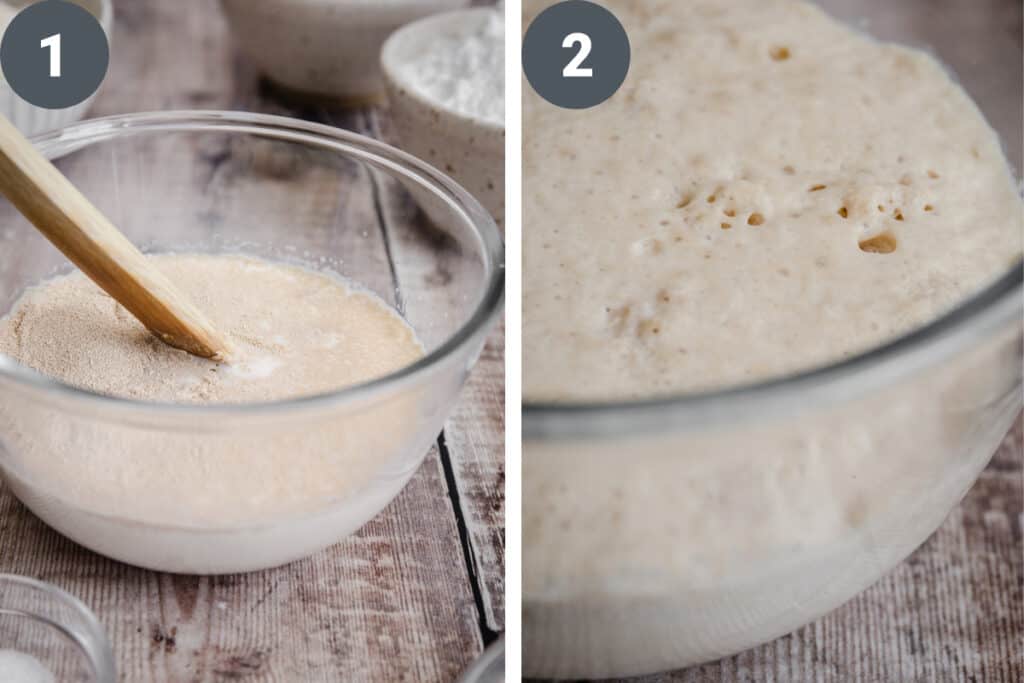
3&4) Psyllium husk. Mix with the water then let stand for 2-4 minutes to form a gel.
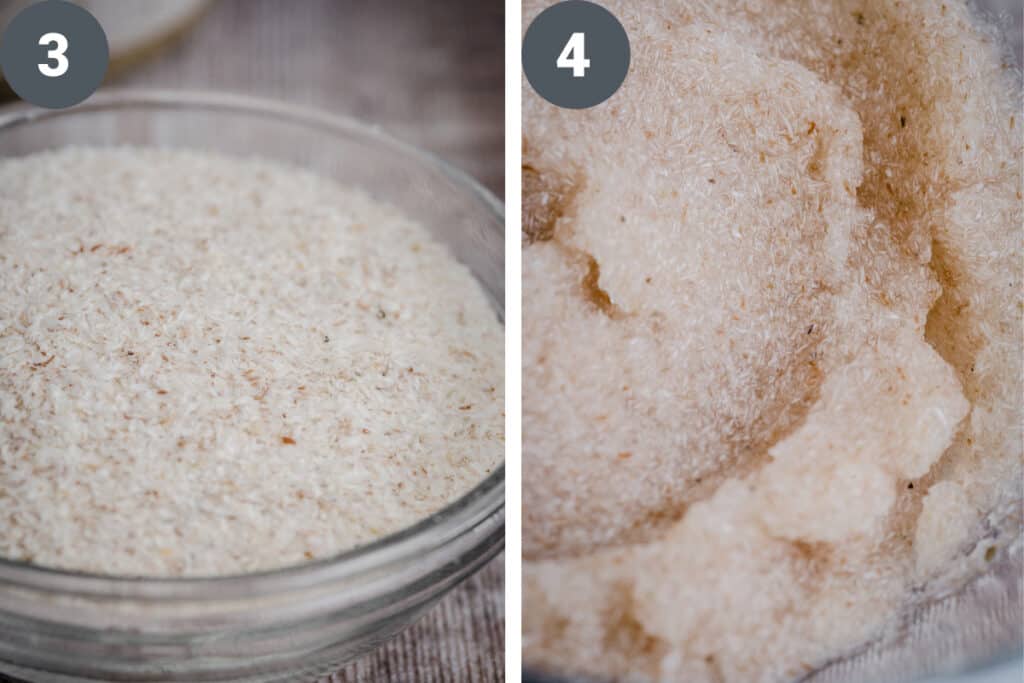
5) Dry ingredients. Mix the sorghum flour with the tapioca starch, potato starch, ground ginger and salt.
TIP. To make sure the dry ingredients are really well combined you can sift them together.
6) Mix. Beat together all the ingredients. Start with the dry ingredients then add the yeast mixture, psyllium gel, melted butter, apple cider vinegar and egg whites. Beat for at least 5 minutes to make sure everything is well combined.
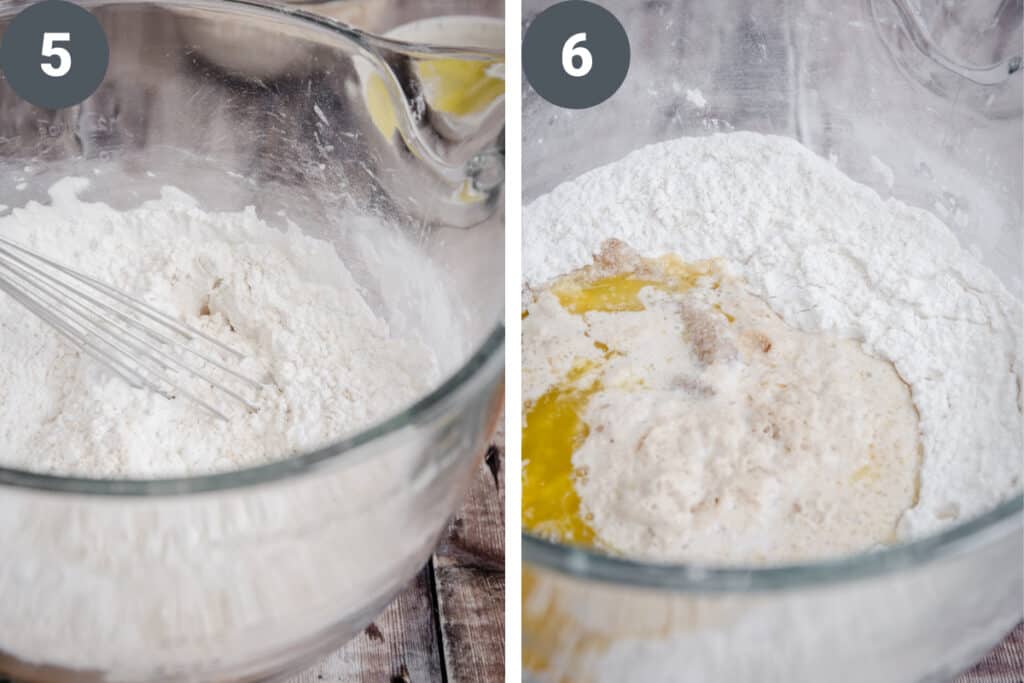
7&8) Shape. With floured hands form the dough into a log shape and place in a greased loaf tin.
TIP. Make sure the surface of the dough is lovely and smooth in the tin, any lumps, bumps or cracks will show up in the baked bread. Now is the time to make it look good.

9&10) Prove. Place the loaf tin in a warm damp place for 1 hour to rise.
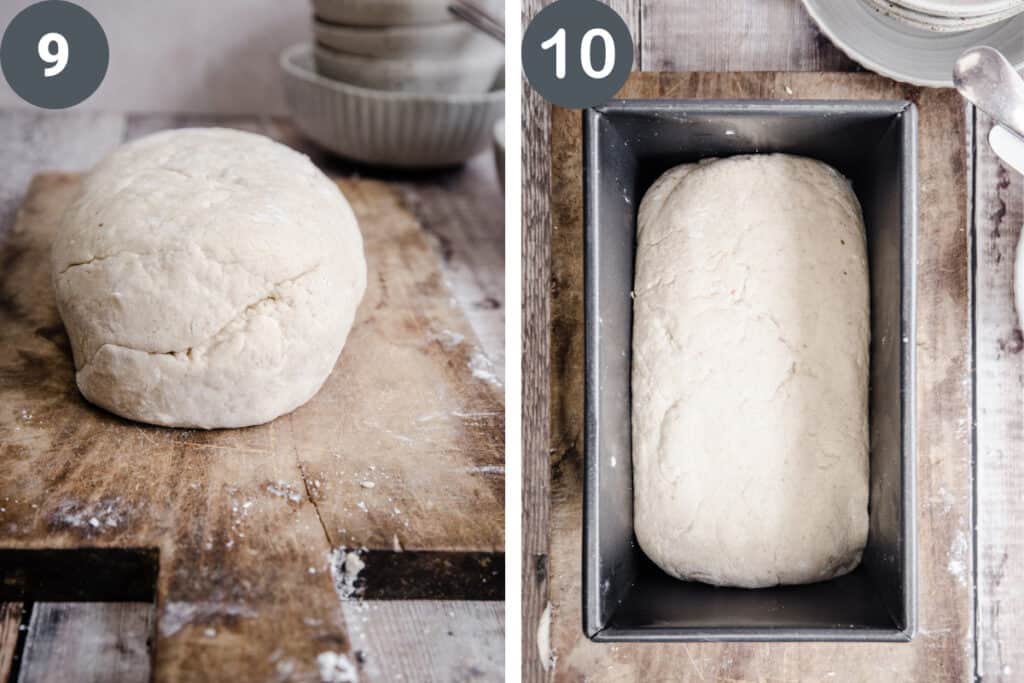
11&12) Bake. Brush the surface of the risen bread with melted butter then bake for 50 minutes.
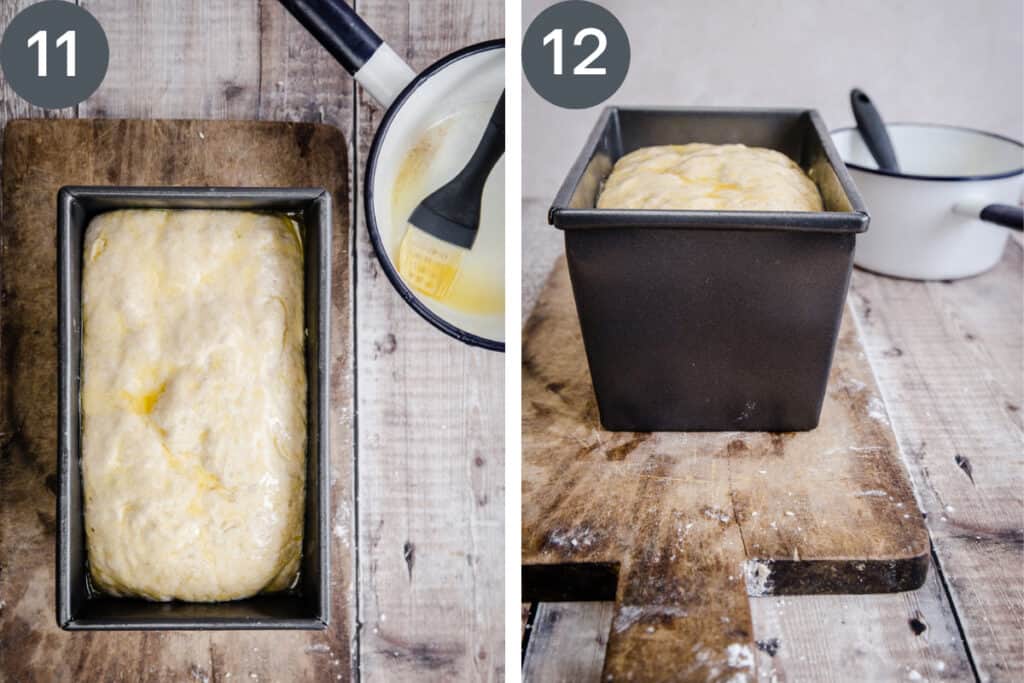
13) Cool. Turn the bread out and cool on a wire rack.
TIP. Gently tip the bread out of the tin straightaway and allow to cool completely on a wire rack to avoid a gummy loaf.
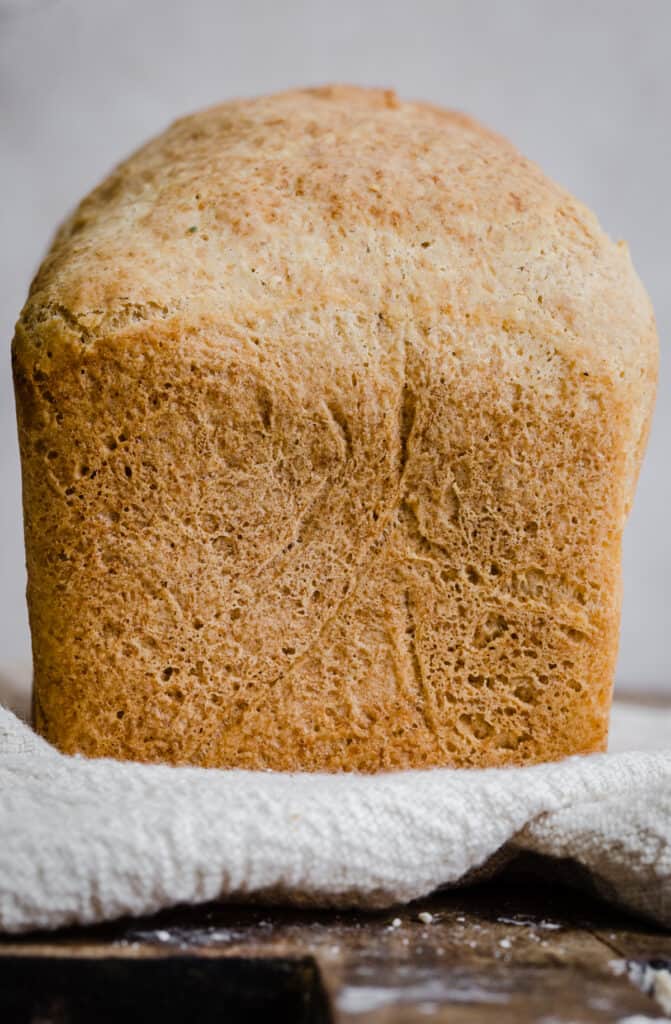
Tools you'll need
 Buy Now →
Buy Now →  Buy Now →
Buy Now → Ingredients you'll need
 Buy Now →
Buy Now →  Buy Now →
Buy Now →  Buy Now →
Buy Now →  Buy Now →
Buy Now →  Buy Now →
Buy Now → 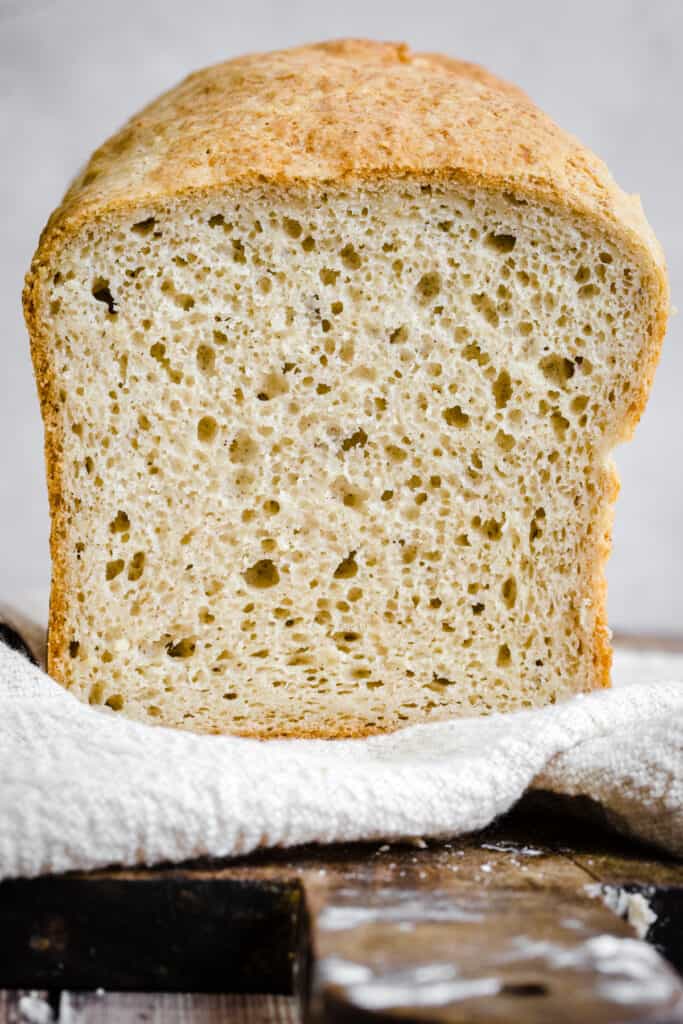
Troubleshooting: My bread won’t rise
There are a couple of factors which may affect the rise of your loaf:
- Yeast. The first thing to do is to check expiry of your yeast. However, even if it is within its expiry it still could be dead. You will know your yeast is alive and well if once it has been added to the milk and sugar the surface is thick, frothy and bubbly. It’s active and ready to use. If the yeast just floats on top of the milk without any change to its appearance then you will need to open a new packet of yeast.
- The Prove. The other issue which might be preventing your bread from rising is how you are proving it.
How to prove your bread
Your yeast might be good and strong but it will only reach its full potential if your bread is given the right environment for proving. And this is:
Warm and slightly damp.
Great places to prove your bread are:
- Utility room – with the tumble dryer on.
- Kitchen counter – on a warm summer’s day with a damp cloth draped over the top of the bowl.
- Bread proving drawer of the oven.
- Boiler room
Ultimate Proving Tip
If you can’t find a decent place in your house then the following method gives consistent results every time:
Place your bread in the middle shelf of the oven (switched off). Slide a roasting dish filled with just boiled water onto the bottom of the oven, then shut the door. The steam of the water will help activate the yeast in the bread and the oven will provide a warm yet damp environment for a successful prove.
Gluten-Free Vegan White Bread
With a few simple switches you can easily make a vegan loaf using this recipe. There is no difference in the two versions at all.
- Whole milk - you can switch for your favourite non-dairy milk. Almond milk or cashew milk work best.
- Butter - you can use either a plant based butter or just olive oil, but if you use the latter you lose the rich buttery taste (it still has a lovely flavour though).
- Egg whites – swap the egg whites for 130g aquafaba.
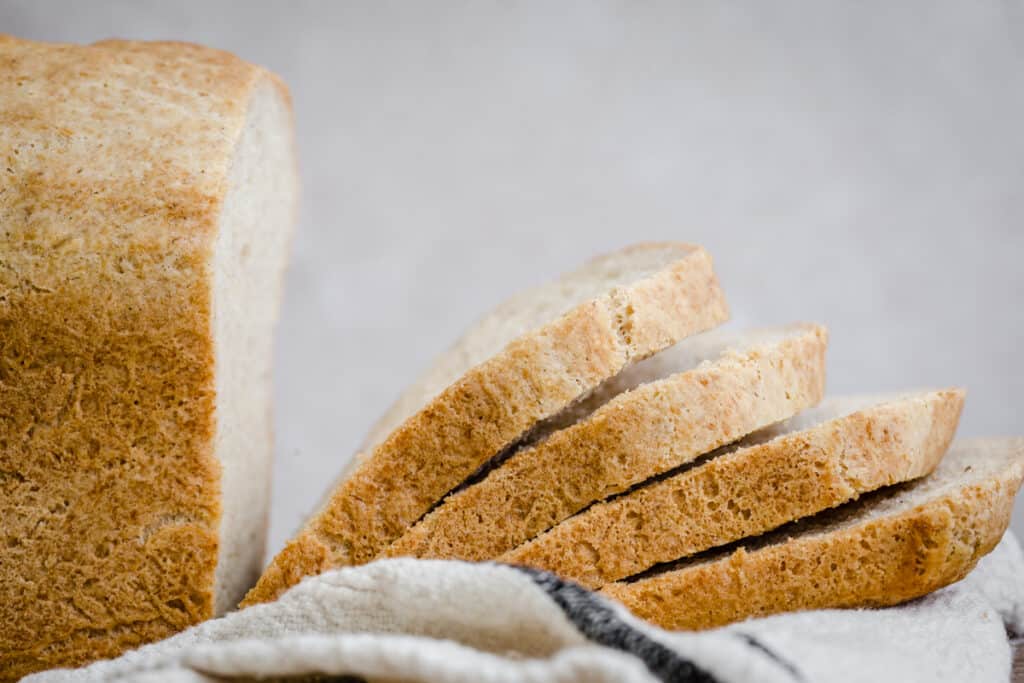
How to store
This bread is really best eaten within 24 hours. Any longer it starts to harden. However it is still great for toast for up to 3 days.
You can store your bread in a bread tin with the cut side of the loaf facing down. The crust acts as a shield to the outside environment. Or you can store in aluminium foil or wrapped in baking parchment.
If you don’t eat all of the loaf within the first day then another option is to freeze it.
How to freeze
Allow the bread to cool completely. You can freeze the bread whole but I prefer to freeze in slices. Double wrap well in cling film and aluminium foil to avoid freezer burn.
You can use the frozen slices straight from the freezer into the toaster, or you can leave to defrost overnight on the kitchen counter.
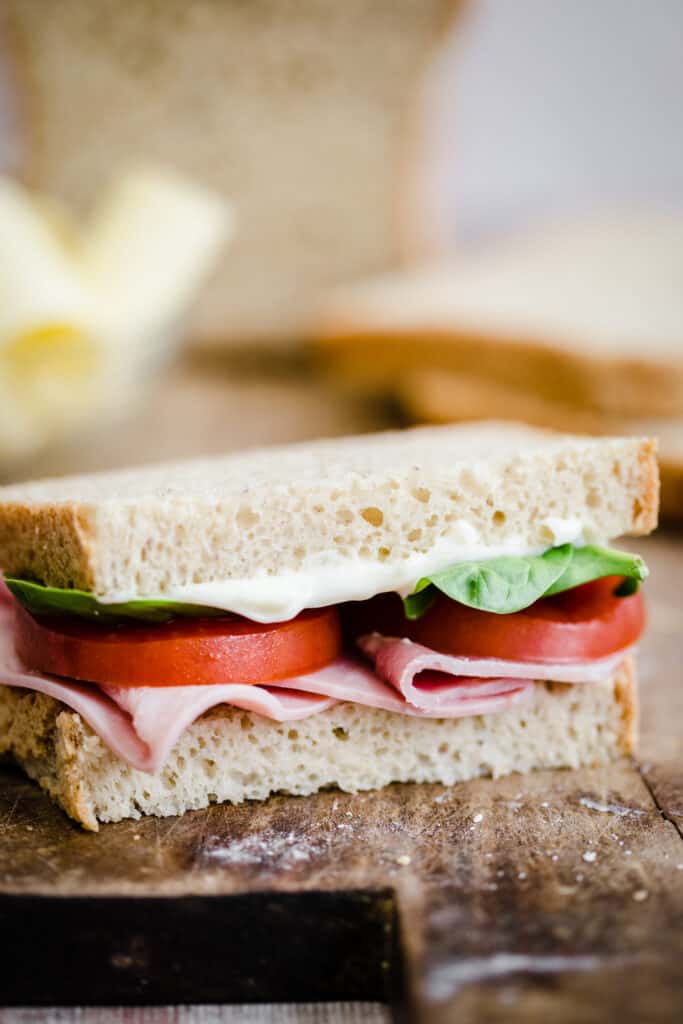
More gluten-free bread recipes you’ll love
- Gluten-Free Irish Soda Bread (vegan)
- Gluten-Free Naan Bread
- Gluten-Free Cheese Bread Rolls
- Happiness Bread
- Gluten-Free Doughnuts
I urge you to give this Gluten-Free White Sandwich Loaf a try. If you do then please leave a comment below and give the recipe a rating which helps others find the recipe on Google. If you then go on to use this recipe as a launch pad for your own culinary creation then I’d also love it if you’d share it and tag me on Instagram. It is so lovely for me to see your versions and variations of my recipes.
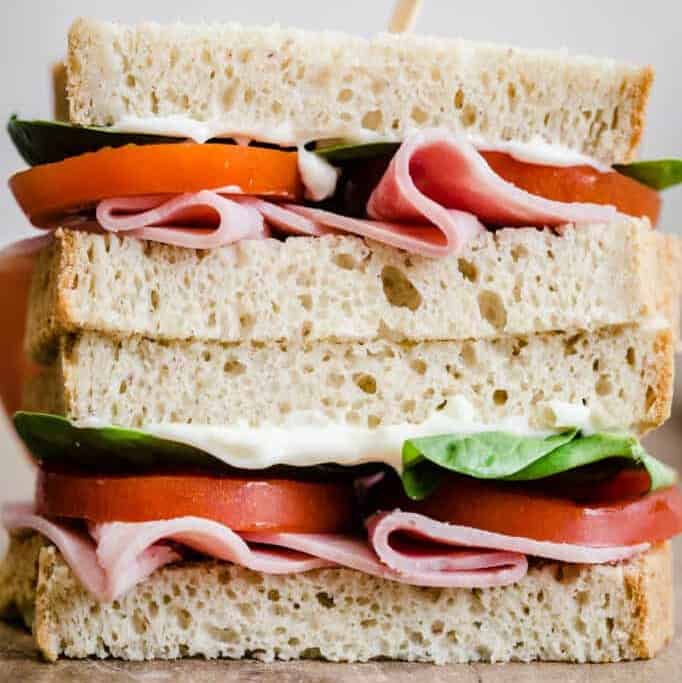
Gluten-Free White Sandwich Loaf
Ingredients
- 7 g active dried yeast
- 220 ml whole milk
- 25 g light soft brown sugar
- 30 g psyllium husk - not ground
- 200 ml water
- 3 teaspoons apple cider vinegar
- 240 g sorghum flour
- 160 g potato starch
- 160 g tapioca starch + a little extra for dusting
- ½ teaspoon ground ginger
- 1 teaspoon kosher salt
- 65 g unsalted butter - melted and cooled slightly + 15g extra (for brushing over the top)
- 4 egg whites - medium eggs
Instructions
- Warm the milk to between 100-115 F / 38-46°C . Then pour into a medium sized glass bowl and stir in the yeast and brown sugar. Rest for 10 minutes until the surface is looking thick and bubbly.
- Stir the water and psyllium husk together in a medium sized bowl until combined. Allow to stand for 2-4 minutes until it forms a gel.
- Whisk the sorghum flour together with the potato starch, tapioca starch, ground ginger and salt in a large mixing bowl or a stand mixer.
- Add the yeast and milk mixture, psyllium gel, apple cider vinegar, cooled melted butter and egg whites.
- Beat together for about 5 minutes until the dough is well combined but still a little sticky to the touch.
- Dust hands with extra tapioca starch and scrape the dough out of the mixer.
- Place on a work surface and roll and shape the dough together into a smooth log shape.
- Place the dough carefully into a lightly greased 3lb loaf tin.
- Place the tin somewhere damp and warm to prove for 1 hour (see notes on proving).
- After the dough has been proving for 50 minutes turn the oven onto 190°C /170°C fan assisted oven / gas mark 5.
- Melt the butter for brushing over the top of the loaf.
- Once the dough has been proving for an hour it should have risen by ⅓, just reaching the top of the tin. Brush the surface with the melted butter then place in the oven to bake for 50 minutes. The loaf is baked when golden brown.
- Remove from the oven and take the bread out of the tin straightaway to cool on a wire rack. Allow to cool completely before cutting.
Video
Notes
Ingredients
- Flours. This recipe hasn’t been tested with any flour substitutions. However an alternative to the sorghum flour is oat flour. An alternative to the tapioca starch or potato starch is arrowroot (although both flours should not be substituted for arrowroot).
- Psyllium husk. This recipe has not been tested with any alternatives.
- Whole milk. Swap for almond milk or cashew milk for a vegan or dairy-free loaf.
- Egg whites. The eggs whites used are 30g each so 120g total in egg whites.
- Butter. Swap for olive oil for a vegan or dairy-free loaf.

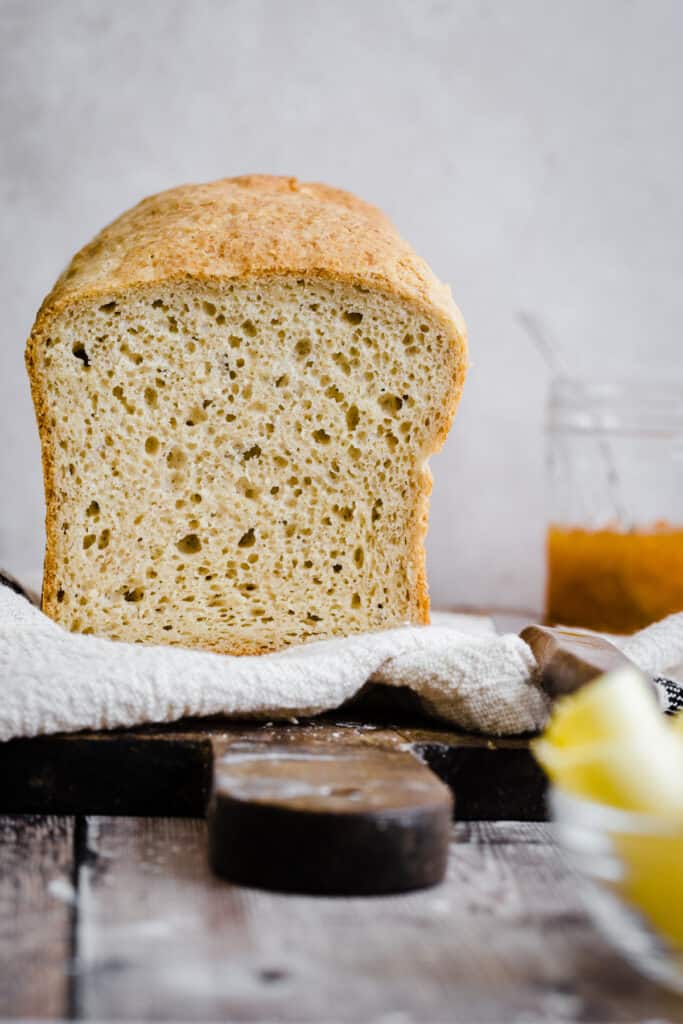
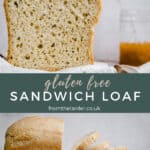
Jane says
I love this loaf and it has really improved my enjoyment of a gluten free, xanthan gum free diet. Thank you so much
Georgina Hartley says
You are very welcome!
Susie says
Hi, I have just made this today and it is absolutely fantastic! My first ever proper loaf with perfect instructions all the way - plus handy tips along the way. Thanks Georgina!
Georgina Hartley says
You are so welcome - I'm so happy you enjoyed your new bread recipe!!
Sarah says
Hi Georgina,
I am sensitive to psyllium husk, so I was wondering if replacing it with ground chia or flax seed, or an egg, would work?
Thank you!
Georgina Hartley says
Hi Sarah, I haven't tried this recipe with a psyllium husk replacement so I can't confirm what the results would be by swapping it for something else.
Marika says
Hi Georgina,
So glad I came across your site! Any suggestions on what I can replace the egg whites with?
Georgina Hartley says
I have replaced them successfully with aquafaba for this recipe.
Sara says
I can’t do dairy or refined sugar. Wondering if I can sub coconut milk and coconut sugar?
Georgina Hartley says
I haven't tried those substitutions. The coconut sugar would be fine but I cannot say for sure on the coconut milk as it won't contain the same amount of protein as the milk which is needed for the soft texture. However, if you do give it a go do let me know how it turned out.
TM says
If you're not vegan, honey is generally an excellent substitute for sugar in bread recipes. (I haven't tried it in this one personally.)
Sarah says
Hi! I am allergic to psyllium husk, can I substitute it for something else? Thanks!
Georgina Hartley says
Hi Sarah, apologies but I haven't tried this recipe with any alternatives at this stage.
Caroline says
I made this today with ground chia seeds instead of psyllium and it turned out great!
Georgina Hartley says
I'm so happy to hear that! Thank you for leaving your feedback.
Jen says
This bread turned out perfect! The best gluten free bread! I also made the dough into buns for hamburgers…they were perfect also! Thank you for this recipe! I substituted almond milk for milk and a mixture of arrowroot powder and white rice flour for the potato starch, also two whole eggs in place of egg whites. So happy with this versatile recipe!
Ruby says
Can you bake bread in a regular oven vs. Convection/fan oven?
Georgina Hartley says
Yes - it's 190°C in a regular oven or 375°F.
Heidi Moore says
Could you please tell me how many grams of egg whites you are using? The size of eggs in a carton varies in the brands I use in the US.
Thank you!
Georgina Hartley says
Absolutely - it's 120g egg whites as each egg white is 30g. Thanks!
Karissa says
Do you leave the dish of water in the oven during baking, or do you remove it after the bread proves?
Thank you for sharing so many goods tips! 🙂
Georgina Hartley says
Remove it after the bread proves.
Mary says
Do you have a bread mkaer version? Thanks
Georgina Hartley says
I don't but some of the commentators here have made it in the breadmaker with great results - scroll through and hopefully you'll find some advice.
mark hadida says
Hi,
love your web site, I am Gluten intolerant and yes, my tummy has told me over time of trying different products, I am xanthan gum intolerant too!
My first success was your pork pies...fabulous.
We can't buy decent gluten free buns here in NZ. and to be honest, I couldn't be bothered with all the fluffing around of making them, only to end up with failure! So I used your recipe for a white loaf, read up on the comments of how to make it in a bread-maker. then added spice, sugar and mixed fruit to the dry ingredients. And hey presto.... less than 2 hours later my bread-maker produced the lightest, moist and well risen (over double the size) Hot Cross Loaf you have ever seen! Love to show you a photograph, but its all been eaten before I thought about taking a pix!
Can't recommend it enough though....thank you.
I might now try to make your normal gluten free loaf...never had any luck before with other recipes!
Georgina Hartley says
Thank you so much and I'm so happy you found success in this recipe - especially by turning into a Hot Cross Loaf - how delicious!!!
Kathryn Chopee says
Hello from Canada
I have just stumbled onto your site and am thrilled so see that your recipes do not include xantham gum! I am looking forward to trying this recipe although will first have to work out the conversion to cups etc..
Just wondering if I could substitute Arrowroot starch for the potato starch?
Thanks so much
Kathy C
Georgina Hartley says
The potato starch has been chosen specifically as it gives great rise to the loaf due to the reaction in the oven. You could replace with arrowroot starch but it doesn't have the same effect and the end result of the loaf would change.
Ellen says
Hello~
Thank you for posting the bread recipe; however, can I use the recipe in the bread machine??
Georgina Hartley says
I haven't tried it in a bread machine but I believe someone else has if you scroll up the comments.
Genevieve says
Hi Georgina! Thanks for this recipe, I've now made it twice, with very different results, and was wondering if you had any advice?
The first time I made it at my parents' house it was AMAZING! Fluffy, tasty, not grainy or gluey like a lot of gluten free breads, almost just like the amazing fluffy white loaves my dad has always made, which I've really missed.
The second time we made it at home and am bewildered at how it's so different! It was all knobbly on the top and sides when it came out of the oven (my wife said she had issues flattening it to smooth). It is sandy and gluey and the texture seems much tighter, other than a holey bit in the middle.
The only differences were in the proving (my parents have two ovens and my dad always proves stuff in one at 40c, whereas we just put a damp hot tea towel over the top, which usually works with pizza dough etc), and in the cooking (they have a brand new fan oven, ours is pretty bog standard). All the ingredients were exactly the same, though it was a different bag of sorghum flour (same brand). Both times we've also used the same yeast brand (Allisons), flour/starch brands (though again, a different bag of tapioca starch), same apple cider vinegar, and done the kneading/mixing in stand mixers with a dough hook.
Do you have any suggestions on what might have gone wrong, or how we could avoid in the future? Thanks!
P.S. The gluten free flour blend has also been a revelation - have made a lemon drizzle loaf and a microwave streamed treacle pudding and both have been amazing! 🙂
Georgina Hartley says
I would say the proving will be a key issue. Have you tried the oven trick that I describe in the main body of this email? I have found that two factors really make a difference in this recipe and that is firstly the freshness of the yeast. I always make sure the yeast is really active before using it in the recipe, and the other is in the prove. It has to be a warm and damp environment. My foolproof way is in a turned off oven with a tray of just boiled water on the bottom of the oven. The dough must be covered (I proved a loaf of bread uncovered last week as I forgot and the bread did not work) - I find plastic wrap is best here as it really creates the damp environment. Do try the bread again with this proving method and let me know how you get on. You might also like to try an oven thermometer if your oven is older the calibration may be off.
Genevieve says
Thank you for the tips, will give that a go and see if it works better!
ET says
In your recipe, you don't mention covering the bread with plastic (cling) wrap.
Georgina Hartley says
Yes you can cover the bread dough with plastic wrap during the proofing, make sure to oil or grease the underside of the cling film to avoid the dough sticking to it when it rises.
Margaret Krug says
This bread was great. I made two loaves from it one in a 9 x5 the sandwich loaf and a holiday bread in a 8x4 pan. The taste was great and it was not sticky inside. The only thing I had was the crust was really hard when I went to slice it but it did make really nice slices. Any idea on why the crust was so hard instead of being soft? My bread did not turn out white it looked more like a wheat bread. Now I am wondering if, after reading the comments above, I used too much psyllium husk powder. This recipe calls for psyllium husk - not ground--does that mean powdered. I have never used that before so a little confused. I put in the 30g. The only changes I made was not using ACV-had a bad experience with it-so used lemon juice, and the pan size. I was so happy that this turned out ,better than ANY GF bread I have made before. Thank you so much for the recipe. Mom's holiday nut bread is back in my recipe box!!! There are pictures on the FB page.
Michelle Moore says
Hi Georgina - I made your pastry recipe at the weekend (my now memorised standard go to) and today I decided to make the bread recipe, on the basis that every recipe of yours that I have tried has been a winner, and yes, here's another one! I don't know how many times I have tried to make a xanthum-free bread, and although the recipe I use tastes great, it never rises much. So I followed your recipe, only substituting with oat flour (and a bit (about 50g) of chestnut flour for added flavour), as I was out of sorghum, and tried your suggestion of the pan of hot water in the oven for the prove - an excellent tip! - and also waiting for it to cool before I cut into it. Worth the wait - just a bit of butter on top for a wonderful treat. Thank you so much - I really appreciate your recipes, especially the confidence I have that they will work every time!
Brenda Seader says
I can't seem to get the video for this and other recipes. Is it because I'm in USA?
Georgina Hartley says
No, the video is available wherever you are. It will be because of the settings on your device. Are you trying to watch it on mobile or desktop? You can try on a different device or adjust the settings on your current one.
Alene says
If I only have ground psyllium husk and I want to make this today, lol!, do you know how much of the ground would replace the the kind you used? That's the trouble with me. I see a recipe and I want to make it now. Thank you!(
Georgina Hartley says
Hi Alene, for every tablespoon of psyllium husk you can use 1 teaspoon psyllium husk powder. Thanks!
Alene says
I made this 2 days ago and it's wonderful! I sliced it up and froze the slices. It is so much better than other gluten free, rice free breads I've made. It holds together and sliced cleanly. What a treat! I had my first peanut butter and jelly sandwich today, without even toasting the bread. My guilty pleasure. 🙂 I ended up using instant yeast because my supply of active yeast seems to have died. No problem at all with that change. And my U.S. whites were the wrong size, so I looked up the volume of British medium whites and was able to remedy that. All in all, a wonderful experience! Thank you so so much! I am forever indebted!
Carol Thomson says
Love love love this bread it will be my “go to” bread recipe forever, I cannot thank you enough.
Georgina Hartley says
Hi Carol - that's such a pleasure - I'm so happy you enjoy the recipe.